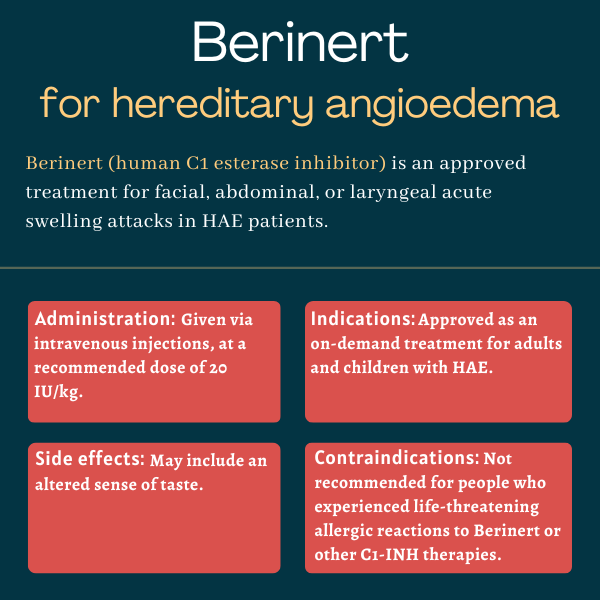
Berinert (human C1 esterase inhibitor) for hereditary angioedema
What is Berinert for hereditary angioedema?
Berinert (human C1 esterase inhibitor) is an approved on-demand treatment for acute swelling attacks in children and adults with hereditary angioedema (HAE).
The therapy, which is administered via an intravenous (into-the-vein) injection, is specifically indicated for abdominal, facial, or laryngeal (throat) swelling attacks. It is marketed by CSL Behring.
Therapy snapshot
| Brand name: | Berinert |
| Chemical name: | C1 esterase inhibitor (human) |
| Usage: | On-demand treatment of acute swelling attacks in people with HAE |
| Administration: | Intravenous injection |
How does Berinert work?
The overproduction of a signaling molecule called bradykinin, which normally promotes blood vessel widening, or vasodilation, is the key driver of swelling attacks in HAE. In addition to its vasodilator effects, bradykinin increases blood vessel permeability, allowing fluids to leak out of blood vessels into nearby tissues, causing swelling in the deeper layers of the skin.
The C1 esterase inhibitor (C1-INH) protein regulates a cascade of inflammatory signaling pathways that ultimately prevent bradykinin production. A deficiency in C1-INH, therefore, can cause bradykinin levels to rise too high. In HAE types 1 and 2, which are the most common disease types, mutations in the SERPING1 gene lead to a deficiency in C1-INH.
Berinert is a concentrated form of C1-INH isolated from the pooled blood of healthy donors. When injected into the bloodstream during an acute attack, the medication helps to restore C1-INH levels, thereby lowering bradykinin production and bringing swelling under control.
Who can take Berinert?
Berinert was initially approved by the U.S. Food and Drug Administration (FDA) in October 2009 for the on-demand treatment of acute abdominal and facial swelling attacks in adolescents and adults with HAE.
In January 2012, its label was expanded to include the treatment of laryngeal attacks, or those affecting the throat and potentially compromising the airways, and to allow Berinert to be self-administered.
Berinert’s label was expanded again in July 2016 to include patients younger than 12, which made it the first and only HAE on-demand treatment to be approved for this patient group.
The medication is similarly approved for the on-demand treatment of HAE attacks in many countries worldwide.
Who should not take Berinert?
Berinert is contraindicated, or not recommended, for patients with a history of life-threatening allergic reactions, including a severe reaction called anaphylaxis, to Berinert or other C1-INH preparations.
It is also not approved as a preventive, or prophylactic, treatment for HAE. Its safety and efficacy for that indication has not been established.
How is Berinert administered?
Berinert is given as an on-demand intravenous injection at the time of an acute swelling attack, and may be self-administered by patients after adequate training. It is given at a recommended dose of 20 international units per kilogram of body weight (IU/kg).
The medication comes as a freeze-dried powder in a single-use vial containing 500 IUs of C1-INH. The contents of each vial must be dissolved in 10 mL of sterile water prior to being infused.
Vials should be stored in powder form in their original carton and protected from light prior to use. The powder should be reconstituted in water using the provided Mix2Vial transfer set or a similar commercially available set.
Once properly mixed, the liquid will be colorless, clear, and free from visible particles. The solution should be administered at room temperature within eight hours. The infusion should be done using the provided syringe and at a rate of about 4 mL per minute.
In some cases, patients or caregivers may be able to administer Berinert at home after receiving proper training on how to do so safely. However, patients who self-administer Berinert for a laryngeal attack, which may compromise the airways, should always seek immediate medical attention after treatment.

Berinert in clinical trials
Berinert’s regulatory approvals were largely supported by data from the international Phase 2/3 IMPACT-1 trial (NCT00168103) and its extension study, IMPACT-2 (NCT00292981).
IMPACT-1 trial
The IMPACT-1 trial evaluated the safety and efficacy of Berinert against a placebo in 124 patients with HAE type 1 or 2 who were experiencing a moderate to severe abdominal or facial swelling attack.
Participants, ages 6-72, were randomly assigned to receive a single dose of Berinert at one of two doses — 10 IU/kg or 20 IU/kg — or a placebo by intravenous injection within five hours of experiencing an HAE attack.
After four hours, patients with insufficient symptom relief could receive a second dose, with those on the 20 IU/kg dose receiving a placebo and the placebo group being treated with the higher dose.
Patients treated with the higher dose of Berinert experienced a significantly shorter median time until they started to feel symptom relief compared with a placebo (30 vs. 90 minutes). That reduction was even greater for severe attacks, with patients on 20 IU/kg of Berinert experiencing the first signs of symptom relief after 30 minutes, compared with 13.5 hours with the placebo.
Moreover, the median time to complete symptom resolution was significantly lower with Berinert (4.9 hours) than with the placebo (7.8 hours).
IMPACT-2 trial
The IMPACT-2 extension study evaluated the safety and efficacy of Berinert’s long-term use for repeated attacks in 57 IMPACT-1 trial participants. Over a median of two years, more than 1,000 attacks were treated with Berinert at its recommended 20 IU/kg dose. In this study, Berinert could be used to treat attacks affecting any part of the body.
Results showed Berinert was well tolerated and led to symptom relief starting within less than 30 minutes, and complete resolution after a median of 15.5 hours.
Notably, Berinert was found to be not only effective for facial and abdominal attacks, as observed in IMPACT-1, but also for potentially life-threatening laryngeal attacks. In those attacks, symptom relief started as soon as 15 minutes, and complete resolution was achieved after a median of 8.4 hours.
Other analyses from IMPACT-1 and IMPACT-2 indicated Berinert was as safe and effective in pediatric patients as it was in adults.
Common side effects of Berinert
The most serious adverse event reported in patients treated with Berinert was an increase in pain severity associated with HAE. The most common side effect reported in clinical trials was dysgeusia, or an altered sense of taste.
Allergic reactions
Hypersensitivity, or allergic reactions, may occur after using Berinert, and can be severe. Epinephrine, a rescue medication for allergic reactions, should be available to all patients being treated with Berinert.
Symptoms of an allergic reaction may include hives, welts, chest tightness, wheezing, and low blood pressure. These symptoms may be similar to those experienced during an HAE attack. If an allergic reaction is suspected, Berinert should be stopped immediately and appropriate treatment administered.
Blood clots
Serious thromboembolic events, or blood clots, have occurred in patients using C1-INH products, including Berinert.
Risk factors for blood clots may include the presence of an indwelling catheter for injections, a history of blood clots, underlying atherosclerosis (plaque buildup in arteries), use of oral contraceptives or other hormonal medications, morbid obesity, and immobility. For patients with these risk factors, the potential benefits of Berinert should be weighed against the risks of potential blood clots. Patients with known risk factors should be monitored while on Berinert and afterwards.
Berinert should not be administered for unapproved indications at higher than recommended doses, as this may increase the risk of blood clots.
Transmission of infectious agents
Berinert is obtained from human blood, and thus may carry a risk of transmitting infectious agents, such as viruses, to the recipient.
Donors whose blood is used to make Berinert are screened for certain viruses to minimize this risk, and various processes during manufacturing are used to remove or inactivate potential viruses from the product. No cases of suspected virus transmission have shown a causal link to Berinert. If a doctor suspects a virus was transmitted to a patient through Berinert, they should contact CSL Behring’s pharmacovigilance department.
Laryngeal attacks
Patients who self-administer Berinert for an acute laryngeal attack, or one affecting the throat and potentially compromising the airways, should always seek immediate medical attention in an appropriate medical facility after treatment, as these attacks may affect breathing.
Use in pregnancy and breastfeeding
Retrospective studies have not reported any complications during pregnancy for women treated with Berinert. However, no prospective clinical studies have been conducted. As such, Berinert should only be given to pregnant women if they clearly need it and only after consultation with their doctor.
It is not known whether Berinert passes into human breast milk, so caution should be exercised when the treatment is administered to a woman who is nursing. Patients who wish to become pregnant or breastfeed while on Berinert should discuss this with their doctors.
Angioedema News is strictly a news and information website about the disease. It does not provide medical advice, diagnosis, or treatment. This content is not intended to be a substitute for professional medical advice, diagnosis, or treatment. Always seek the advice of your physician or other qualified health provider with any questions you may have regarding a medical condition. Never disregard professional medical advice or delay in seeking it because of something you have read on this website.
Recent Posts
- 1 lonvo-z dose keeps most HAE patients attack-free up to 3 years
- For many of us, becoming a patient advocate wasn’t optional
- FDA extends Orladeyo approval to children as young as 2
- With chronic illness, we can’t brush off holiday stress so easily
- Abrupt danazol stop in HAE can cause temporary hepatitis: Study
 Fact-checked by
Fact-checked by 


